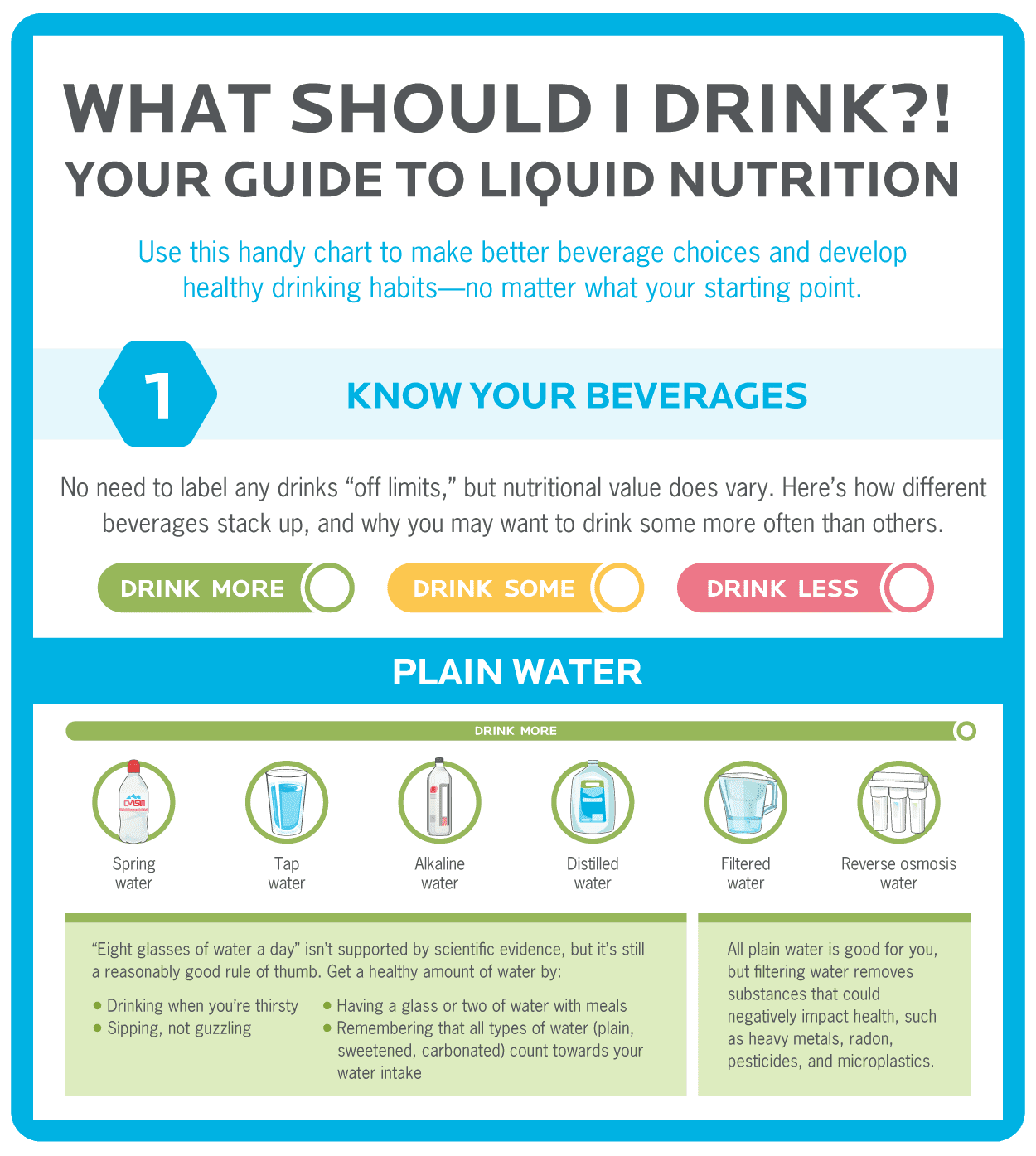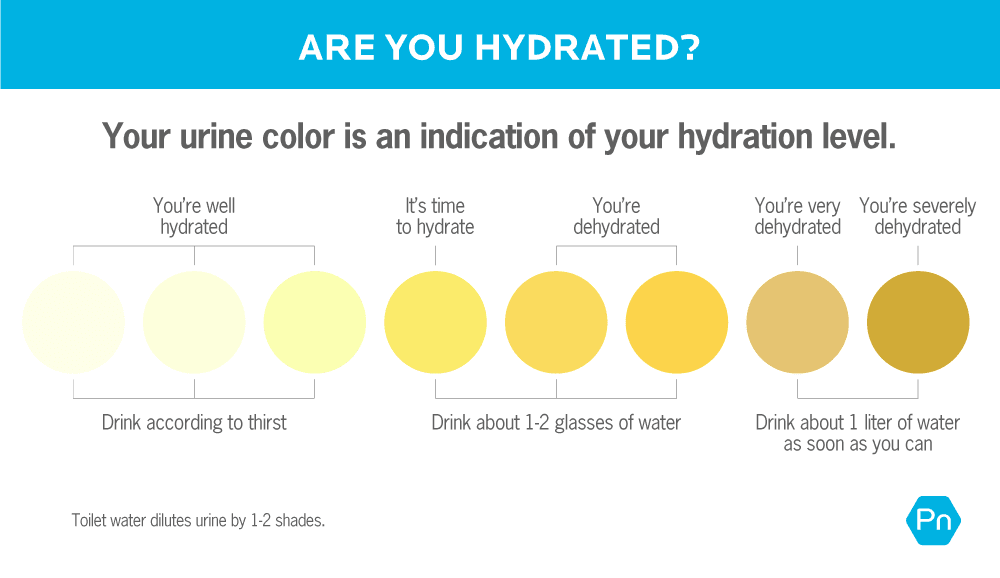[ad_1]
Every month, tens of thousands of people ask Google:
“How much water should I drink?”
And Google points them to stories that go something like this:
“Most people are dehydrated—and they don’t know it.”
They list headaches, constipation, bad breath, and other dehydration dangers. And they encourage you to guzzle water, lest you dry up like a sad raisin.
In reality, however, the answer to “how much water should I drink?” is incredibly short and simple:
If you’re thirsty, drink something. If you’re not thirsty, don’t worry about it.
Sooo… why doesn’t this article end right here?
Because there are a few exceptions.
(And maybe you’re one of those exceptions. Feel free to skip ahead if you’re an athlete or exerciser, you’re pregnant, or you’re over the age of 65.)
Plus, I’m guessing you might not believe that staying hydrated is so simple.
So let’s walk through how much water you should drink together.
Want to know exactly what to drink?
Download our complete guide to liquid nutrition. You’ll learn:
- That you don’t have to swear off the drinks you love in the name of better health and nutrition.
- How to make beverage choices that match your lifestyle, taste preferences, and goals, no matter what your starting point.

Download your FREE ‘What Should I Drink?!’ PDF guide here.
Consider this visual resource the uncomplicated answer to every question you (or your clients) have ever had about what to drink.
Why do you need water?
You might’ve already heard:
Your body is more than 60 percent water.
It uses that fluid for some obvious things—blood, sweat, tears—and some less obvious things: regulating body temperature, helping your body make hormones, and stopping your brain from smashing into your skull when you’re doing burpees.
It’s true that chronic dehydration can raise your risk for a host of problems no one wants to have: kidney stones, urinary tract infections, and negative cognitive and physical performance.1
But there’s a difference between chronic dehydration (being mildly dehydrated a lot of the time) and acute dehydration (which is more severe, and requires timely intervention).
Most people are not chronically dehydrated.
When I give workshops, I often go through client case studies—asking the audience to tell me what they would suggest.
Without fail, someone raises their hand and proclaims: “The first thing I’d do is have them drink more water.”
“Why?” I ask.
That’s when they tell me: “Well, most people are dehydrated.”
This is a misconception. According to the Center of Disease Control’s National Health and Nutrition Examination Survey (NHANES), the average US adult easily meets—and even surpasses—their water needs.2
Thirst: Actually a pretty reliable sense.
Most people are like my new puppy, Charley.

Charley’s cute, right? She’s also not dehydrated.
Charley drinks when she’s thirsty, and she does just fine—no special formulas or calculations required.
And our sense of thirst works just as exquisitely.
A part of our brain, called the lamina terminus, monitors blood volume and blood osmolality (the ratio of salt to liquid), among other factors, to determine whether the body needs more or less fluid. If blood volume drops and osmolality rises, the brain turns up that dry feeling in our tongues and throats.3
How much water do you need?
Humans need about 3 liters (101 ounces) of fluid per day, though the exact amount will vary from person to person.
Depending on someone’s diet, about 34 ounces (1 liter) of that will probably come from food, especially if they’re eating watery foods like veggies, fruit, prepared oatmeal, or yogurt.
That leaves about 2 liters (67 ounces) to get from beverages.
So the old “drink 8 cups of water a day”—which adds up to 64 ounces—is actually a pretty good general rule.
However:
How much water you need will depend on a range of factors, like age, weight, health status, and activity level, to name a few. If you’re small and sedentary, you might need less than 3 liters. If you’re in a larger body and also exercise in a hot humid environment, you’ll need more.
That’s why thirst is probably a much better gauge than forcing yourself to guzzle a predetermined volume.
Unless, however, you’re an athlete, elderly, or pregnant.
Does coffee really dehydrate you?
Caffeine increases fluid output somewhat, which shouldn’t come as a surprise to anyone who’s ever had a cup of coffee before boarding a flight. (Damn you, airport cappuccino.)
Those extra trips to the restroom, however, don’t necessarily lead to dehydration.
In one study, researchers asked men to drink either four cups of coffee or four cups of water.
Though the coffee drinkers produced slightly more urine over 24 hours, they were no less hydrated than the water drinkers.4 Other research found the same with cola.5
Bottom line: A cup of coffee, tea, or cola are just as hydrating for you as the same amount of water.
(For more about the pros and cons of coffee, see: All About Coffee.)
How much water should athletes and exercisers drink?
Though your thirst mechanism works well during rest, it doesn’t function as well during activity.
We’ve known this since the 1930s when researchers asked a man and a dog to walk just under 20 miles (32 km) in the 104F (40C) heat of Boulder City, Nevada. Both the man and the dog could drink whenever they wanted. But only the dog finished well hydrated. The man, on the other hand, lost about 6 pounds (3 kg) of his body mass through water loss.6
Research shows that, when people doing intense exercise rely on thirst alone, they tend to under consume fluid, replacing only about half of what they lose.7
People can lose 1-2 percent of their body weight very quickly when they’re exercising intensely in a hot, humid environment. That’s enough to raise heart rate, body temperature, and your perception of effort.8 For aerobic efforts, like cycling, it’ll also slow you down.9
In addition to the liter of fluid you get from food, consume at least 3 liters (101 ounces) of fluid on the days that you exercise.
That breaks down as follows:
- 1 liter (34 ounces) before and during exercise
- 1 liter (34 ounces) after exercise
- 1 liter (34 ounces) throughout the day, with roughly 1-2 cups of water with each meal
During long-duration and/or intense exercise, of course, you lose more than just water. This includes sodium, potassium, and other electrolytes—and it’s important to replace those, too. Otherwise you risk hyponatremia (sodium deficiency).
So, instead of plain water, consume an electrolyte beverage (such as a sports drink) for exercise lasting more than an hour in intense heat and/or humidity or more than two hours in any condition.
How much water should you drink during pregnancy?
When you’re growing a human, your blood volume increases, which boosts your overall fluid needs.
As a general rule of thumb, you’ll want to consume roughly 1 liter (34 ounces) more during pregnancy than you consumed before. If you’re not sure if you’re getting enough, check your urine. (See Are you hydrated? below.)
If your urine is pretty dark, you’re probably underdrinking. If it’s light to clear, you’re doing great.
How much water should older people drink?
When elderly folks are admitted to the hospital, they’re often dehydrated.
That’s probably because, as we get older, our thirst mechanisms don’t work like they used to. Neither do our kidneys. Certain medications can increase urine output, too. Plus, our bodies don’t seem to hold as much fluid.10
All of that increases our risk of becoming dehydrated.
If you’re 65 or older:
- Drink an additional 8 to 16 ounces (.25 to .5 liters) of fluid—over and above your level of thirst.
- Consume whatever beverage you enjoy—an electrolyte drink, iced tea, or even diet cola. (For more on why hydration is more important than worrying about artificial sweeteners, read: Should you drink diet soda?)
- Monitor your urine and drink up if it’s bright yellow or darker. (See Are you hydrated? below for specifics.)
- Know the symptoms of dehydration: dark urine, fatigue, dizziness, headaches, dry mouth.
How much should I drink to lose weight?
A few years back, researchers did a series of studies that found drinking water could increase calorie burning. 11 12
However, the researchers predicted an extra 2 liters (67 ounces) of water might only boost energy expenditure by about 96 Calories.
For context, that’s about the number of calories in a medium banana.
Maybe you’re thinking: Doesn’t water at least dull the appetite, helping people to eat less?
It might.
One study found that downing half a liter (16 ounces) of water before meals helped people eat less and consequently lose weight.13
You can also take small sips of water between bites, which will help you eat more slowly. (And actually, eating slowly is one of the best ways to regulate your food intake. Read more: How slow eating can transform your body.)
How to calculate your water needs
How do you make sure you’re hydrated?
You have two options.
Option #1: Drink when you’re thirsty
This super-simple option works for most people, including:
✓ People who live in cool-to-moderate climates
✓ People younger than 65
✓ Non-athletes
Option #2: Monitor your urine
Some people occasionally suffer from acute dehydration.
Like when lots of stuff is coming out of both ends due to food poisoning or an infection. Or when exercising intensely in a hot climate.
As long as they replace what they lost, it’s no big deal.
How do you know if you’ve replaced what you’ve lost?
The answer: Check your toilet.
The more dehydrated you are, the greater your urine osmolality (saltiness).
Luckily, you can also assess osmolality through color: The greater the osmolality, the darker your urine.
If you compare your urine color to what’s shown on the chart below (see “Are You Hydrated?”), you’ll get an answer that’s almost as accurate as an expensive hydration test that your physician or trainer would run in the office.14
This option works best for:
✓ People who live in hot, dry environments and worry about dehydration
✓ People whose jobs make on-demand drinking difficult (such as a healthcare worker who wears a mask for a 12-hour shift)
✓ People who exercise moderately in hot and/or dry environments
✓ People who are pregnant
✓ People age 65 and older
Are you hydrated?
Use this chart to assess your hydration status.
The colors assume you’ve peed in a cup.
If you don’t want to do that (who does?) just assume that the toilet water will dilute your urine color by 1 or 2 shades.

In summary, you’re probably doing just fine.
In terms of hydration, with the above exceptions in mind, you can keep going along just like my puppy Charley.
Drink when you’re thirsty, and hopefully not from the toilet.
References
Click here to view the information sources referenced in this article.
If you’re a coach, or you want to be…
Learning how to coach clients, patients, friends, or family members through healthy eating and lifestyle changes—in a way that’s personalized for their unique body, preferences, and circumstances—is both an art and a science.
If you’d like to learn more about both, consider the Precision Nutrition Level 1 Certification. The next group kicks off shortly.
[ad_2]
Source link
